Mehrabian Rule: How Nonverbal Communication Builds Stronger Interpersonal Relationships
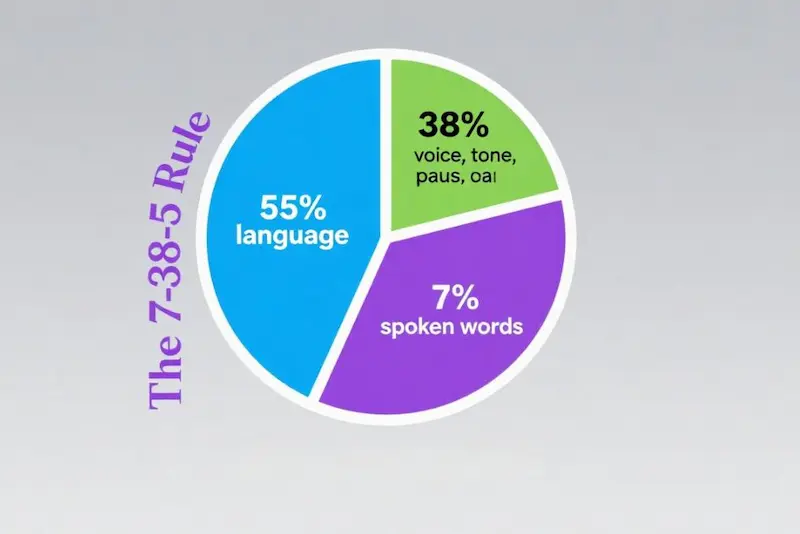
How to Build Meaningful Relationships: It’s All About the Mehrabian Rule (Not Gifts or Dinners)
We’ve all been there: You spend 20 minutes explaining a new idea to a colleague, but they still seem confused. Or you share a personal win with a friend, and their response feels flat—even though your words were enthusiastic. Why do these disconnects happen?
The answer lies in a powerful psychological principle called the Mehrabian Rule. Contrary to what many think, strong relationships don’t depend on fancy dinners, expensive gifts, or even “perfect” wording. They rely on how you communicate—specifically, the nonverbal signals that make up 93% of what others perceive. Let’s break down what this rule means and how to use it to strengthen your connections.
What Is the Mehrabian Rule (7-38-55 Rule)?
The Mehrabian Rule—often called the “7-38-55 Rule”—was developed by Albert Mehrabian, a Persian-American psychologist and professor emeritus at the University of California, Los Angeles (UCLA). His groundbreaking research, published in his 1971 book Silent Messages, revealed a surprising truth about face-to-face communication:
- 7% of your message comes from the words you use (the literal content, like facts, opinions, or data).
- 38% comes from your tone of voice (speed, volume, pitch, and pauses).
- 55% comes from nonverbal cues (facial expressions, eye contact, gestures, and body posture).
This doesn’t mean words are irrelevant—they matter for clarity. But when your tone or body language conflicts with your words, people trust the nonverbal signals first. For example:
If you say, “I’m excited about this project!” but speak slowly with a slouched posture and no smile, your colleague will likely think you’re uninterested. The 38% (tone) and 55% (body language) override the 7% (words).

Real-Life Examples of the Mehrabian Rule in Action
To see how the Mehrabian Rule works, let’s look at common scenarios in the U.S.—from classrooms to workplaces—where nonverbal cues make or break communication.
Example 1: A College Professor Teaching Literature
Imagine a professor leading a discussion on The Great Gatsby. She wants students to understand Gatsby’s longing for Daisy—so she doesn’t just read a quote:
- 7% (words): “Notice how Gatsby says, ‘I’ll wait here all night if necessary.’ He’s desperate to reconnect.”
- 38% (tone): She slows her voice when saying “all night,” lowers her pitch to convey vulnerability, and pauses before “desperate” to emphasize the emotion.
- 55% (body language): She leans slightly forward (showing engagement), maintains soft eye contact with the class, and gestures gently toward the book (as if pointing to Gatsby’s feelings).
Students don’t just hear about Gatsby’s longing—they feel it. A post-class survey might show 80% of students remembered the scene, compared to 40% if she’d only read the quote flatly. This aligns with Mehrabian’s research: nonverbal cues make emotional messages stick.
Example 2: A Manager Giving Feedback
A manager wants to praise a team member for a successful client presentation. Here’s how the Mehrabian Rule shapes the interaction:
- 7% (words): “Your presentation was clear and helped us win the client—great work.”
- 38% (tone): He speaks with a warm, upbeat pitch, raises his volume slightly on “great work,” and pauses to let the praise sink in.
- 55% (body language): He smiles, nods, and maintains direct eye contact (not checking his phone). He might even give a brief, friendly pat on the shoulder.
The team member leaves feeling valued. If the manager had said the same words in a monotone voice while scrolling through emails (conflicting nonverbal cues), the praise would feel insincere—even if the words were positive.

How to Apply the Mehrabian Rule for Stronger Relationships
The Mehrabian Rule isn’t just a theory—it’s a practical tool. Here’s how to use it to improve your communication in friendships, romantic relationships, and the workplace.
1. Align Your Tone with Your Message
Your tone is the “emotional soundtrack” of your words. To make sure it matches your intent:
- For empathy: Speak slowly and softly. If a friend shares a tough day, say, “That sounds really hard,” with a calm, gentle tone (avoid fast, loud speech, which can feel dismissive).
- For excitement: Speed up slightly and raise your pitch. When a family member shares good news (e.g., “I got the job!”), respond with, “That’s amazing!” in an upbeat, energetic tone.
- For clarity: Slow down and emphasize key words. If explaining a work task, say, “The deadline is Friday—so let’s check in on Wednesday,” with a steady tone and a pause before “Friday.”
A study by the American Psychological Association (APA) found that mismatched tone and words is one of the top causes of miscommunication in relationships. Aligning them eliminates confusion.
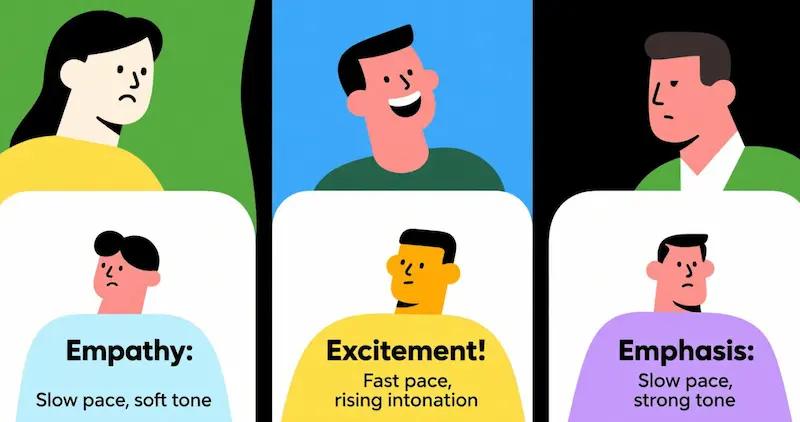
2. Master High-Impact Nonverbal Cues
The 55% of communication that comes from body language is often the easiest to adjust. Focus on these four cues:
- Eye contact: In U.S. culture, moderate eye contact (not staring) signals trust. When talking to someone, hold eye contact for 50-70% of the conversation—look away briefly to avoid making them uncomfortable.
- Facial expressions: Smiles convey warmth, but genuine smiles (called “Duchenne smiles,” which crinkle the eyes) are more trusted than forced ones. If you’re happy for someone, let your smile reach your eyes.
- Posture: Stand or sit up straight (but not stiffly) to show confidence. Slouching can make you seem uninterested or insecure—even if you’re fully engaged.
- Gestures: Use open gestures (e.g., palms up, arms uncrossed) to appear approachable. Avoid crossing your arms or checking your phone—these signal disengagement.
Practice these in low-pressure situations first: Try adjusting your posture during a casual call with a friend, or focusing on eye contact during a coffee run.
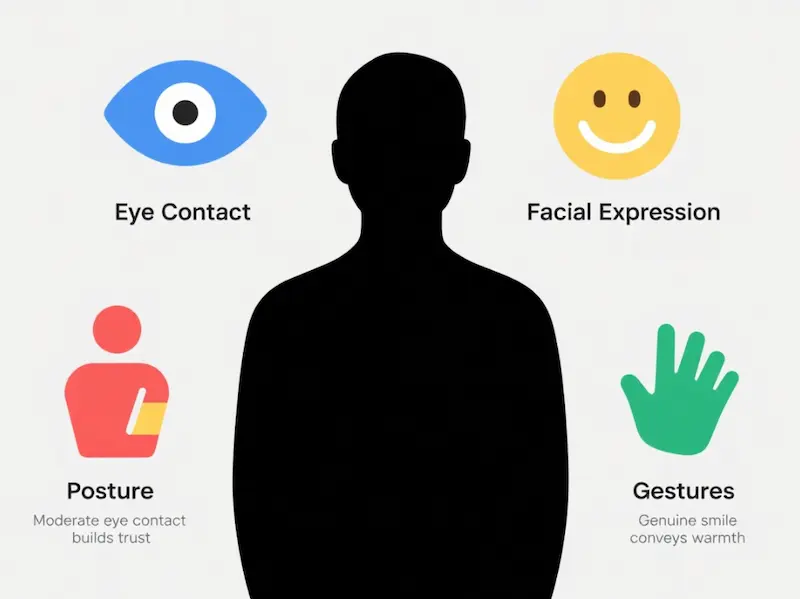
3. Read Others’ Nonverbal Signals
The Mehrabian Rule works both ways—learning to interpret others’ nonverbal cues helps you respond better. Here are common signals and what they mean:
- If someone is leaning back, checking their watch, or avoiding eye contact: They might be bored or in a hurry. Wrap up your point or ask, “Do you have a minute to chat, or should we circle back later?”
- If someone is nodding, leaning forward, and smiling: They’re engaged! Keep the conversation going, or ask for their input: “What do you think about this?”
- If someone’s tone is sharp, even if their words are neutral: They might be frustrated. Say, “You seem a little stressed—want to talk about it?” This shows you’re paying attention to their whole message.
Misreading nonverbal cues can lead to misunderstandings. For example, if a coworker says, “Fine,” in a tight tone, don’t take it at face value—ask follow-up questions to clarify.
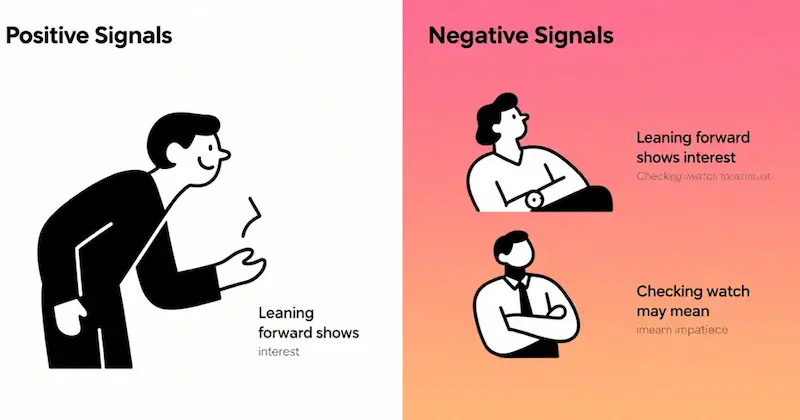
4. Reflect and Practice Regularly
Like any skill, mastering the Mehrabian Rule takes practice. Try these steps to improve:
- Record yourself: Use your phone to record a short video of yourself explaining a topic (e.g., your weekend plans). Watch it back—note your tone, posture, and gestures. Do they match your message?
- Role-play with a friend: Ask a trusted friend to practice a scenario with you (e.g., giving feedback, sharing bad news). Afterward, ask them: “How did my tone and body language make you feel?”
- Reflect after conversations: At the end of the day, spend 5 minutes thinking about a key interaction. Did the nonverbal cues align with the words? What would you change next time?
Over time, these habits will become second nature—and your relationships will strengthen as a result.
Why the Mehrabian Rule Beats Surface-Level Gestures
In U.S. culture, we often associate “building relationships” with grand gestures: treating a friend to a fancy dinner, buying a coworker a holiday gift, or sending a expensive birthday present. But the Mehrabian Rule shows these actions only go so far.
Surface-level gestures don’t create trust—authentic communication does. For example:
- A coworker might appreciate a coffee gift card, but they’ll trust you more if you listen actively (eye contact, nodding) when they share a work challenge.
- A partner might love a birthday gift, but they’ll feel more loved if you say, “I’m proud of you,” with a warm tone and a hug (nonverbal cues that match your words).
Mehrabian’s research supports this: People remember how you make them feel more than what you buy them. Nonverbal communication creates emotional connection—and that’s the foundation of lasting relationships.
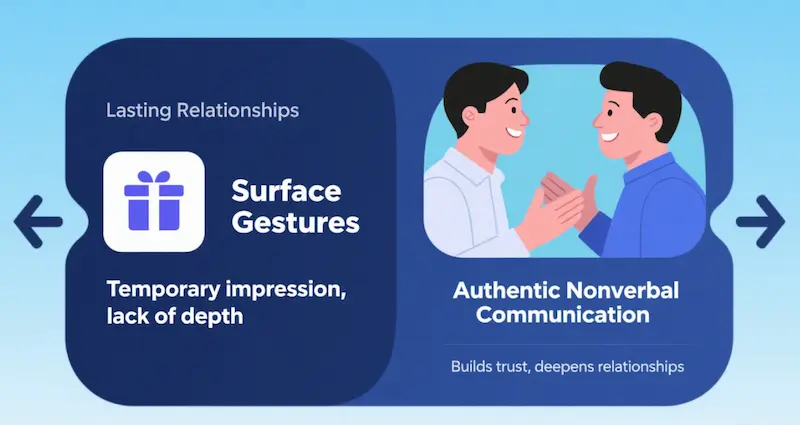
The Mehrabian Rule is a reminder that communication is more than just words. By focusing on your tone (38%) and body language (55%), you can connect with others more deeply, avoid misunderstandings, and build relationships that last—no expensive gifts required.
Whether you’re chatting with a friend, presenting at work, or talking to your partner, small adjustments to your nonverbal cues can make a big difference. Start with one tip this week (e.g., practicing eye contact or aligning your tone with your message) and see how it changes your interactions.
What’s your experience with the Mehrabian Rule? Have you ever noticed a time when nonverbal cues made or broke a conversation? Share your story in the comments below. And if you found this guide helpful, share it with a friend who wants to improve their communication skills—let’s help each other build stronger relationships!






